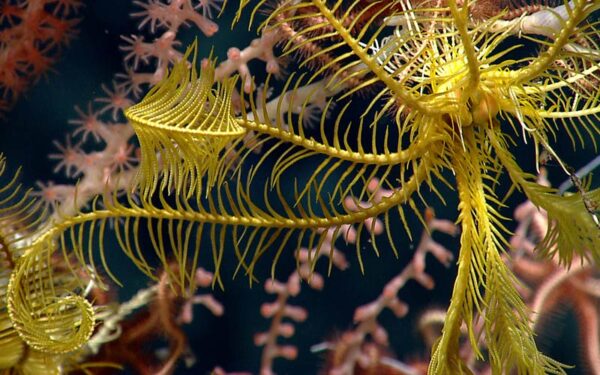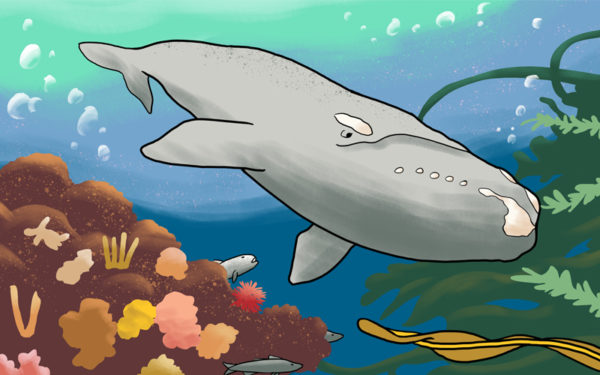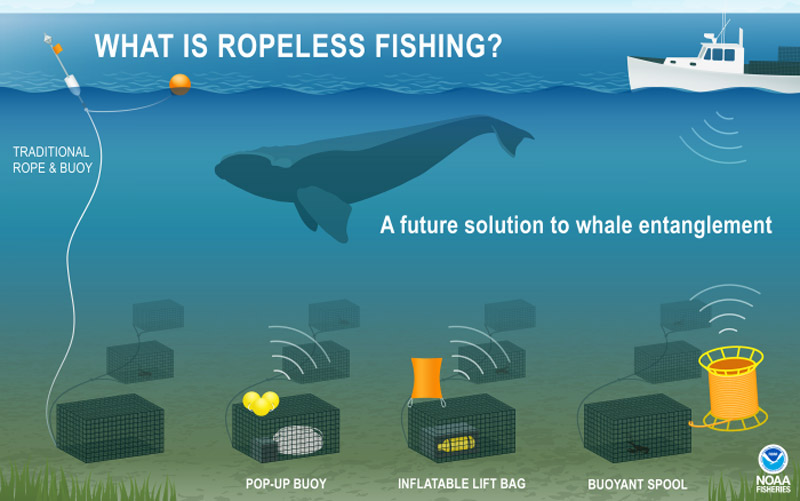
Ropeless fishing offers an alternative that could recover right whales and preserve the livelihood of New England’s iconic lobstermen and women. Image: NOAA
Anyone who has spent time on the ocean in New England has seen the brightly colored buoys bobbing on the surface. These buoys mark the location of lobster traps on the seafloor. More than three million of those traps are spread throughout our regional waters. Unfortunately, the ropes (also known as vertical lines) connecting these buoys to traps can create a dense maze that threatens critically endangered North Atlantic right whales as well as other wildlife.
Accidental entanglements in these vertical lines account for more than half of all right whale deaths. If lobstermen transition to ropeless fishing gear when and where right whales are present, the species has a better chance of recovery.
Moving to ropeless gear systems (also known as pop-up, buoyless, or on-demand systems) is a significant change in fishing practices. And, while it’s not ready for prime time today, significant progress toward this transition is being made with fishermen’s help.
Ropeless fishing gear can reduce fatal right whale entanglements
Today, fewer than 336 North Atlantic right whales remain on the planet – and fewer than 75 are females likely to give birth. Tragically, due to vessel strikes and entanglements, at least 50 animals have died or sustained serious injuries since 2017 in the U.S. and Canada. According to the International Union for Conservation of Nature, North Atlantic right whales are one step away from extinction.
Ropeless fishing provides a long-term solution.
Over the past decade, the government has required lobstermen to make short-term improvements to their gear, such as inserting weak links in their lines or using weaker rope. The assumption is that this modified gear will break when an adult right whale gets entangled. But these measures are unproven, and they still leave rope in the water that can entangle and kill calves, juveniles, and other wildlife.
Currently, the only way to significantly reduce the risk of entanglement is to close an area to fishing when right whales are predicted to be there. But these closures come at a cost to lobstermen who cannot easily move their traps to other locations.
Ropeless fishing offers an alternative that could recover right whales and preserve the livelihood of New England’s iconic lobstermen and women.
Transitioning to ropeless fishing gear in areas of high risk to right whales and other wildlife is possible. But making this transition requires adequate federal and philanthropic funding, additional technological innovations, and continued collaboration with the lobster industry and other stakeholders.
How ropeless fishing works
Ropeless fishing systems create a safer ocean. They allow lobstermen to retrieve traps from the ocean floor without using the traditional, persistent vertical lines that entangle marine wildlife. The technology necessary to retrieve marine equipment off the ocean floor has existed for decades, and recently, it has performed well in commercial trap/pot fisheries. Here’s how it works:
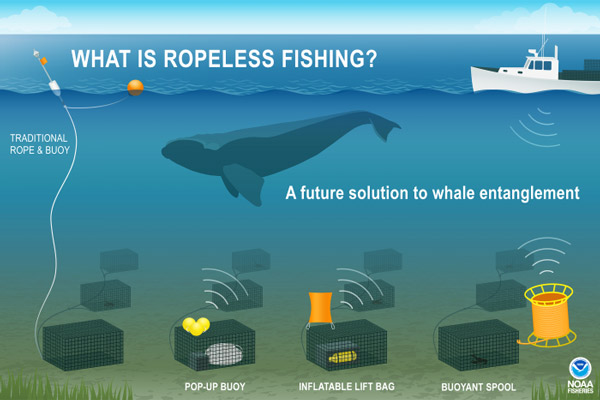
To retrieve their traps, lobstermen send an acoustic signal from a transducer on their boat to a release mechanism attached to the first trap or string of traps (called a trawl). As shown below, that mechanism could be a pop-up lid attached to a line and buoy, an inflatable lift bag, or a buoyant spool. The signal triggers a release that allows the ropeless system to rise to the surface. Lobstermen can then haul their traps using traditional fishing practices.
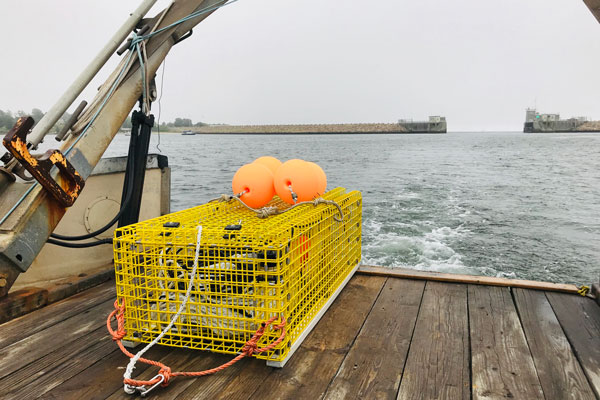
Overcoming challenges to adopting new systems
Ropeless fishing offers a promising solution to entanglement in those areas of our ocean where whales and gear co-occur, but a few challenges remain. Here’s what we need to continue advancing ropeless fishing:
- A universally accepted method for tracking and recording gear location: To avoid gear conflicts between lobstermen and other fishermen operating in the same area, ropeless tracking devices must allow all fishermen (not just lobstermen) to “see” the location of the systems in real time.
Currently, two tracking systems have emerged. The simplest and least expensive method is a digital map that plots GPS positions as the systems are dropped. And, though it’s less accurate at pinpointing gear if it gets moved in a storm or by another boat, it’s still a good interim solution. More expensive – but also more accurate – is an acoustic-based system where the systems and passing boats “talk” to one another. This is the best long-term solution, especially where fisheries overlap. - Gear modifications based on fishermen’s input: Several trials are underway to help identify appropriate and necessary gear modifications based on the depth and/or oceanographic features of particular fishing grounds. We must continue this work until fishermen trust the safety of ropeless systems in all types of weather, currents, and distances from shore.
- More funding: Setting lobstermen up with ropeless gear systems and upgrading their communications equipment to get real-time data comes at a high cost. Using today’s prices, it would require hundreds of millions of dollars for the entire lobster fleet to transition. However, based on current right whale behavior, the entire fleet may not have to make that transition. We also expect the price of ropeless systems to come down as competition between manufacturers and economies of scale play out. Regardless, the financial support of federal and state governments as well as philanthropists is necessary.
The road to ropeless gear is collaborative
The transition to ropeless fishing is not only possible – it’s imperative in areas of high risk to right whales. But we must work together. Fishermen, scientists, engineers, regulators, conservationists, seafood distributors, legislators, philanthropists, and consumers each play a key role.
CLF’s plan for action over the coming years includes ensuring:
1. Strong regulations. We need regulations that reduce the number of vertical lines across the Northeast. And, we need regulations that eliminate vertical lines in areas of high risk, while also allowing for ropeless fishing in those areas.
2. Improved accuracy and consistent standards to track gear location. As noted above, all fishermen must have confidence in their ability to “see” where ropeless systems are to reduce the likelihood of gear conflicts. Work is ongoing to solve this issue.
3. Market demand for lobster caught with ropeless fishing gear that pays fishermen a premium for their increased time and effort. Consumers want to buy sustainable seafood and support local fishermen. Many distributors, retailers, and restaurants already have sustainability goals as well. As the quantity of this lobster increases, additional efforts to directly connect fishermen and markets will be necessary.
4. Additional economic support from Congress to accelerate the transition to ropeless fishing. Currently, funding for this transition relies on limited federal funding through appropriations, NGOs, and philanthropists. Ask your representatives to support the SAVE Right Whales Act to increase funding for new science and technology to protect right whales.
Learn more
No one wants to see North Atlantic right whales go extinct in their lifetime, and public support for their protection is high. That’s why CLF is supporting the transition to ropeless gear and pushing for more stringent measures to keep them safe from other vessel strikes and other threats.
Read more about CLF’s work to save the North Atlantic right whale from extinction.


